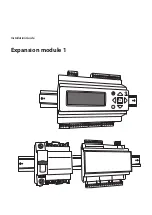
14
Low fire adjustment screw
Located under cap
(Turning clockwise increases gas flow)
Figure 8: DR300 – 400 1:1 Negative Pressure Air/Gas Ratio
Control Valve
Figure 9: DR500 – 1800 1:1 Negative Pressure Air Gas
Ratio Control Valve
Figure 10: DR2000 - 5000 1:1 Air/Gas Ratio Control Valve
Figure 11: DR3500 – 5000 SKP25 Regulating Gas Valve
Actuator & SSOV
3.5
DIFFERENTIAL AIR PRESSURE (DR2000
– DR5000)
•
The Dynaforce® 2000 – 5000 operates on the
principle of differential pressures. Operation of the fan
generates a signal which is matched on the gas side
by the 1 to 1 air/gas ratio control valve.
•
The differential air pressure measurement is made
between the high and low pressure taps across the
fan discharge and the fan static discharge. All
differential air pressures are noted at full firing rate.
There are two pressure taps at the fan discharge and
care must be taken to tee into the correct line. The
correct line may be identified by tracing it back to the
ratio control valve where the identification of the
tapping is stamped into the die cast actuator.
•
The differential gas pressure measurement is made
between the high and low pressure taps across the in-
line metering gas orifice. Check this value to confirm
that it matches the differential air pressure while the
appliance is firing.
•
The controls on this appliance may fire the burner
from 20% up to 100 % of rated input.
•
Differential manifold gas pressure will be reduced as
burner input is reduced.
•
All reference gas pressure measurements must be
made at 100% of rated burner input.
•
The differential gas manifold pressure is pre-set at the
factory through the ratio gas valve. Adjustment of
manifold pressure is not normally required for proper
operation. It may be necessary to adjust the low fire
adjustment screw located on the ratio control valve
actuator in order to achieve acceptable light off under
soft start field conditions.
•
Always check settings posted on boiler test label.
3.6
GAS MANIFOLD DIFFERENTIAL
PRESSURE ADJUSTMENT (DR2000 –
DR5000)
Tampering with gas valve adjustments after startup and
commissioning will void the warranty on the gas valve
assembly and the burner.
The appliance’s manifold gas pressure IS NOT field
adjustable after startup and commissioning. The gas valve
pressure ratios have been factory set with an internal bias
adjustment to ensure a 1:1 air/gas ratio on operation.
Tampering with this adjustment will void the warranty on
the gas valve assembly and the burner. An appliance
supplied with a properly sized gas line, properly sized
meter and a minimum gas supply pressure (See Table 7
for minimum allowable inlet gas supply pressure) while
firing at full rate will ensure full burner input. The manifold
pressure supplied to the burner is a differential pressure.
This pressure is the result of the difference in two gas
pressure measurements. A differential manifold gas
pressure measurement should not be made until you have
measured the gas supply pressure. Gas supply pressure
must be at least at minimum allowed with all appliances on
the gas line firing at full rate before a manifold pressure
measurement is made. Use the following procedure to
check gas supply pressure with a manometer connected
to the inlet pressure tap on the gas line connection at the
rear of the appliance.
Junction box for
power with
actuator position
indicator
High fire air/gas ratio adjustment
(use slotted screwdriver for
adjustment, counter-clockwise
increases CO
2
)
Low fire air/gas ratio adjustment
(use T-40 for adjustment,
clockwise increases CO
2
)
Lift top cover to access high fire
air/gas ratio adjustment
(use 3mm allen key for adjustment,
counter-clockwise increases CO
2
)
Low fire air/gas ratio adjustment
(use T-40 for adjustment,
clockwise increases CO
2
)
Gas Inlet
Actuator
Flange
Valve
Flange
Summary of Contents for DRH300
Page 2: ......
Page 6: ......
Page 38: ...32 13 Place toggle switch setting to REMOTE for remote operation if required...
Page 69: ...63 PART 12 EXPLODED VIEW 19 1 2 3 4 5 6 7 8 9 10 11 12 13 14 15 16 17 18 20...
Page 70: ...64 21 22 23 24 26 35 34 33 32 31 30 29 28 27 25 36 37 38 39 40 42 43 56...
Page 77: ...71 PART 13 ELECTRICAL DIAGRAMS...
Page 78: ...72...
Page 79: ...73...
Page 81: ...75...
Page 82: ...76...
Page 83: ...77...
Page 86: ......
















































